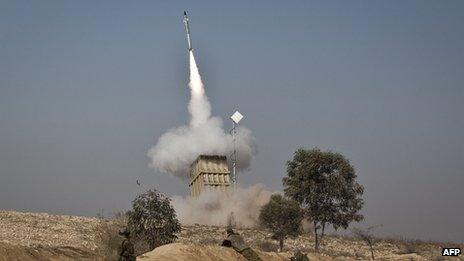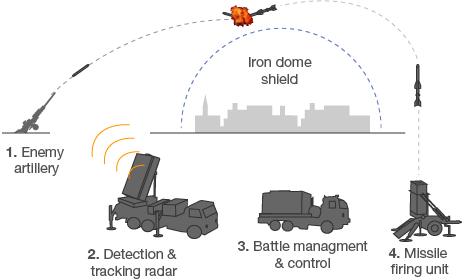Israel's Iron Dome: Doubts over success rate
- Published

Iron Dome was developed by an Israeli defence contractor but paid for mainly by the US
A leading US expert on missile defence has raised doubts about the efficacy of Israel's Iron Dome defence system.
Israeli officials say it hit some 84% of the targets engaged in last year's conflict with Hamas in Gaza.
But Professor Theodore Postol of the Massachusetts Institute of Technology suggests the defence system's success rate may have been "drastically lower".
The success of the Iron Dome was one of the most significant military aspects of Israel's brief campaign.
During this upsurge in fighting - dubbed Operation Pillar of Defence by the Israeli military - Israeli aircraft, drones and artillery bombarded Palestinian targets, while Palestinian groups fired over 1,400 rockets into Israel.
The Iron Dome missile defence system - built by the Israeli company, Rafael, but largely funded by the US - was rushed into service to defend against the Palestinian missile threat.
Track-record
Mr Postol has a track-record in debunking claims made for state-of-the-art missile defence systems.
In the wake of the 1991 Gulf War after which lavish praise was directed at the Patriot defensive system used by the Americans to defend against incoming Iraqi Scuds - Mr Postol showed that the Patriot's defenders - like the Patriot itself - were wide of the mark.
Patriot's success rate, he argued, could have been less than 10%, perhaps even zero. It may actually have hit nothing.
Mr Postol's criticism of the Iron Dome rests upon the nature of the warhead carried by the interceptor missile and the observed trajectories - or flight paths - of the launches he has studied from the November 2012 conflict.
In essence he believes that the only way Iron Dome can be sure of destroying the warhead of an incoming rocket is to hit it head on.
"If the interceptor is flying a crossing or diving trajectory compared to that of the incoming rocket," he told me, "then you are not going to destroy the warhead. Even hitting the incoming warhead side-on will probably not have sufficient energy to detonate it, he argues.
'Deception'
Mr Postol says that while he cannot say what the performance of Iron Dome was in Operation Pillar of Defence, "all the available evidence unambiguously indicates a drastically lower level of performance than the 84% claimed by the Israeli Defense Forces (IDF)."
His view is that the successful hit rate on incoming warheads could be as low as 5-10%.
Mr Postol says that if the IDF wants to make such claims, then it should provide the data to back them up.
He acknowledges that it might have been "a reasonable strategy for Israel to claim that Iron Dome was working, as an excuse not to invade Gaza at an enormous cost to both sides. "
But he argues that "continuing such a deception can only result in the misappropriation of limited defence assets".
Mr Postol says that "as an American supporter of Israel's right to self-defence", he does not feel comfortable seeing the US spend money on a weapon system "that hardly works".
A spokesman for Israel's ministry of defence responded to Mr Postol's critique by saying that it strongly rejected the "unsubstantiated study published recently regarding the performance of Israel's 'Iron Dome' system".
"The baseless claims do not in any way reflect the performance of 'Iron Dome' in the last year and a half, since it has been put into operational service."
"The population of the centre and south of Israel," the spokesman added, "experienced - first hand - the system's achievements during Operation 'Pillar of Defence', which proved itself with an interception rate of over 80%."
"The security establishment is more than content with the system's impressive results and will continue to acquire more 'Iron Dome' batteries," he added, concluding that, in short, "the system saves lives".
Israel's Iron Dome missile shield

- Published15 November 2012